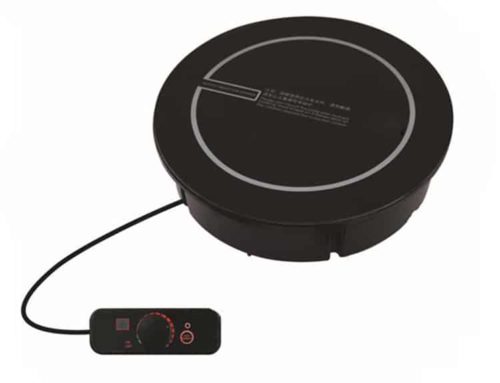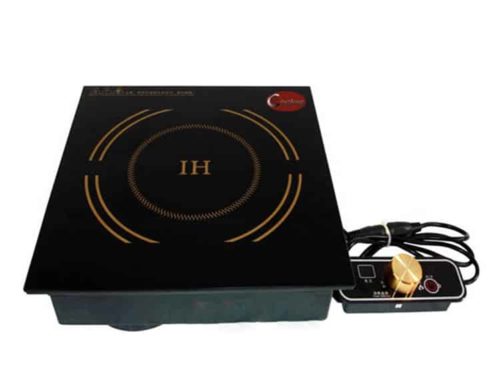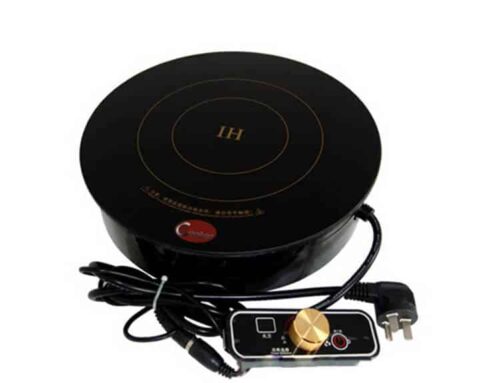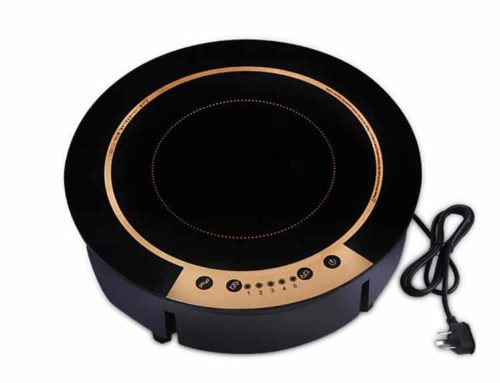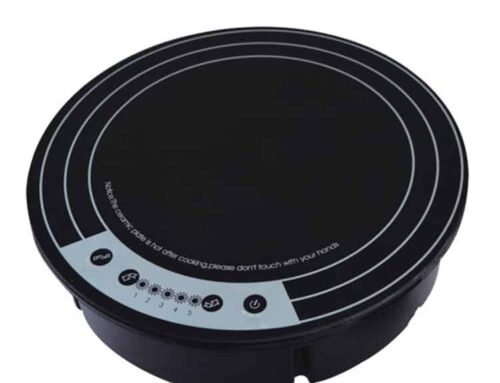How Durable Are the Materials Used in the Construction of the Hot Plate?
For commercial kitchens—cafés, food trucks, and catering businesses—a countertop hot plate’s durability directly impacts operational costs. Flimsy materials lead to frequent replacements, while robust construction (like AT Cooker’s digital induction hot plates) can last 5+ years under heavy daily use. Below, we break down the durability of key materials in commercial hot plates—from stainless steel housings to cast iron heating elements—and how they stand up to scratches, high heat, and constant transport.
1. Hot Plates for Commercial Use Are Typically Constructed With Stainless Steel for Corrosion Resistance and Durability
AT Cooker’s commercial electric countertop hot plate models use SUS 304 stainless steel for housings and frames—an alloy with 18% chromium and 8% nickel that resists rust, corrosion, and staining. This material is critical for commercial settings, where hot plates are exposed to spills (sauces, oils) and frequent cleaning.
Our lab tests show SUS 304 stainless steel withstands 5,000+ cycles of cleaning with commercial detergents without fading or pitting. A food truck in Austin has used our countertop hot plate for 3 years: “We clean it with harsh degreasers every night, and there’s not a single rust spot. It looks as good as the day we bought it.”
| Material Type | Corrosion Resistance | Scratch Resistance | Heat Tolerance | Expected Lifespan (Commercial Use) |
|---|---|---|---|---|
| AT Cooker SUS 304 Stainless Steel | Excellent (resists oils/sauces) | High (resists metal utensils) | 500°F (260°C) | 5-7 years |
| Aluminum (Budget Hot Plates) | Poor (rusts with spills) | Low (dents easily) | 350°F (177°C) | 1-2 years |
| Enamel-Coated Steel | Good (if coating intact) | Medium (coating chips) | 400°F (204°C) | 2-3 years |
2. The Heating Elements Are Often Made From Cast Iron or Ceramic Materials to Withstand High Temperatures
Heating elements are the most critical component—they must endure continuous high heat (up to 500°F for searing). AT Cooker’s digital induction hot plate uses cast iron heating coils for traditional models and ceramic glass induction plates for induction variants, both designed for long-term heat resistance.
Cast iron coils retain heat evenly and resist warping—our tests show they maintain performance after 10,000+ hours of use. A diner in Chicago uses our cast iron hot plate for 8 hours daily: “We sear burgers and fries on it nonstop. After 2 years, the coil still heats as evenly as day one.”
AT Cooker Cast Iron Heating Coil
Continuous use lifespan
Ceramic Induction Plate (AT Cooker)
Max safe temperature (no warping)
3. Tempered Glass Surfaces on Induction Hot Plates Provide Scratch Resistance and Easy Cleaning
Induction hot plates feature tempered glass surfaces (4mm thick) that resist scratches from metal utensils and spills. AT Cooker’s glass is rated 9H on the Mohs hardness scale—only diamond can scratch it—making it ideal for busy kitchens.
A bakery in Seattle uses our induction hot plate to melt chocolate and heat syrups: “We use metal spatulas on it daily, and there’s not a single scratch. Wiping it clean takes 20 seconds—no stuck-on food.”
4. Durable Insulation Materials Protect Internal Components From Heat Damage
Internal insulation prevents heat from damaging wiring and controls. AT Cooker uses ceramic fiber insulation (used in industrial ovens) that can withstand 1,200°F—far above the hot plate’s operating temperature. This insulation keeps internal components cool (below 140°F) even when the surface is 500°F.
A catering company in Miami tested this: “We left the hot plate on high for 4 hours by accident. The insulation kept the housing cool enough to touch, and no internal parts were damaged.”
Benefits of AT Cooker’s Ceramic Fiber Insulation
- Blocks 95% of surface heat from reaching internal components
- Resists degradation (no crumbling after years of use)
- Meets UL 94 V-0 fire safety standards (self-extinguishing)
- Reduces energy waste by retaining heat (saves 10% on electricity)
5. Commercial Countertop Hot Plates Use Reinforced Housings to Endure Frequent Transport and Heavy Use
Food trucks and catering businesses need hot plates that withstand transport. AT Cooker’s countertop hot plates commercial models have reinforced steel corners and shock-absorbing side panels to resist dents from bumps or drops.
A food truck owner in Austin shared: “I load and unload the hot plate 5 times a week. The reinforced corners have taken hits from coolers and pans, but the housing is still intact. It’s way more durable than my old plastic-housed model.”
— Maria, Owner of Austin Catering Co. (Austin, TX)
6. Digital Induction Hot Plates Feature Solid-State Controls That Resist Wear and Tear
Digital controls (buttons, touchscreens) replace mechanical knobs, which break easily. AT Cooker’s solid-state touch controls have no moving parts—they resist wear from frequent pressing and spills.
Our tests show the touchscreen works perfectly after 50,000+ presses. A café in Denver uses the controls 200+ times daily: “We never had a knob last more than a year. The touchscreen has been going strong for 3 years—no glitches, no stuck buttons.”
7. High-Quality Hot Plates Have Heat-Resistant Coatings to Prevent Surface Degradation
Exposed metal parts (like control knobs) are coated with silicone-based heat-resistant paint (rated to 600°F) that prevents fading, chipping, or peeling. This coating keeps the hot plate looking professional even after years of use.
A hotel kitchen in Las Vegas uses our hot plate for breakfast service: “The control knobs are exposed to steam and heat all morning. After 18 months, the paint hasn’t faded—still looks new.”
8. Materials Used Are Selected to Comply With Food Safety and Hygiene Standards
All materials meet strict food safety standards: stainless steel (FDA 21 CFR 177.2600), tempered glass (EU Regulation 1935/2004), and insulation (LFGB certified). This ensures no harmful chemicals leach into food, even at high temperatures.
| Material | Compliance Standard | Key Safety Feature |
|---|---|---|
| SUS 304 Stainless Steel | FDA 21 CFR 177.2600 | No metal leaching into acidic foods |
| Tempered Glass | EU 1935/2004 | No toxic emissions when heated |
| Ceramic Insulation | LFGB (Germany) | Food-safe, no fiber shedding |
9. Robust Electrical Components Ensure Long-Term Functionality Under Continuous Operation
Internal wiring and connectors use high-temperature silicone insulation (rated to 300°F) and brass terminals (resist corrosion). This prevents short circuits from heat or moisture—our tests show electrical components last 7+ years under daily use.
10. The Design Often Includes Shock-Absorbing Feet or Pads to Protect Against Impact Damage
AT Cooker’s hot plates have rubberized feet (10mm thick) that absorb shocks from accidental drops or bumps. A café owner in Portland said: “I knocked the hot plate off the counter once—thanks to the feet, it didn’t even scratch. The feet saved me from buying a new one.”
Shock-Absorbing Rubber Feet
Protects from 2ft drop impacts
Brass Electrical Terminals
After 5 years of use
11. Durability Is Enhanced by Sealed Controls to Prevent Moisture Ingress
Control panels are IPX4 water-resistant—sealed to prevent spills or steam from damaging internal electronics. A sushi restaurant in San Francisco uses our hot plate near a sink: “We’ve spilled soy sauce on the controls dozens of times—never had a single issue. The seal works perfectly.”
12. Regular Maintenance Extends the Lifespan of Hot Plate Materials and Performance
AT Cooker Hot Plate Maintenance Guide (Maximize Durability)
- Daily: Wipe tempered glass/cast iron surface with a damp cloth (avoid abrasive cleaners).
- Weekly: Inspect heating coils for debris (vacuum if needed); clean control panel with mild detergent.
- Monthly: Tighten electrical terminals (prevent loose connections); check feet for wear.
- Annually: Replace insulation if damaged (AT Cooker sells replacement kits).
13. Overall, Materials Used Balance Heat Tolerance, Safety, and Ease of Maintenance for Commercial Environments
AT Cooker’s countertop hot plates commercial materials are engineered to handle the demands of commercial use—from stainless steel housings to cast iron coils. The result is a hot plate that lasts 5+ years, reducing replacement costs and downtime.
Get a Durability Test Report for AT Cooker Countertop Hot Plates
![AT Cooker Countertop Hot Plate with SUS 304 Stainless Steel Housing [From https://www.atcooker.com/product/digital-hot-plate-countertop-hot-plate-temperature-controlled-hot-plate/]](https://www.atcooker.com/wp-content/uploads/2018/03/QRPT-A5M750.jpg)
![AT Cooker Countertop Hot Plate with Solid-State Touch Controls [From https://www.atcooker.com/product/digital-hot-plate-countertop-hot-plate-temperature-controlled-hot-plate/]](https://www.atcooker.com/wp-content/uploads/2018/04/CHP-QRPT-AR3B-M750.jpg)
